| Line 100: | Line 100: | ||
*[[Ollivander|Mr. Ollivander]] |
*[[Ollivander|Mr. Ollivander]] |
||
*[[Ollivander's Wand Shop]] |
*[[Ollivander's Wand Shop]] |
||
| ⚫ | |||
| − | *[[Wand wood]] |
||
*[[Wand]] |
*[[Wand]] |
||
| ⚫ | |||
*[[Wand core]] |
*[[Wand core]] |
||
Revision as of 03:40, 21 August 2010
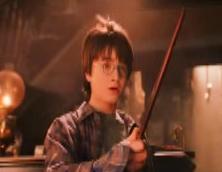
Harry Potter's wand choosing him.
- "You talk about wands like they’ve got feelings... like they can think for themselves."
- — Harry Potter to Mr. Ollivander[src]
Wandlore is an ancient, complex, and mysterious branch of magic dealing with the history, abilities, and actions of wands, quasi-sentient magical tools used by wizards and witches to cast spells. This particular branch of magic is carefully studied by wandmakers such as Ollivander.
The study of wandlore
Its beginnings
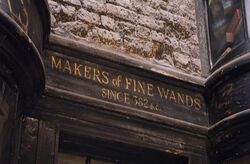
A sign outside of Ollivander's Wand Shop.
Wandlore may have been explored first by ancient wizards more than two-thousand years ago. This can be deduced from the peeling sign of Mr. Ollivander's Wand Shop which reads, "Ollivanders: Makers of Fine Wands Since 382 B.C."[1] In the beginning of wizarding history, the magical forces of the wand may have been experimented upon and explored through the ages, with all its findings written down, as with many other mysteries of the world, each with its dedicated and brilliant explorers. And like those fields, it is further comprehended as time goes on.
Study of the lore
After magical education, a person seeking to become a wandmaker must become the apprentice of a skilled wandmaker. From there, they may undergo the study of wandlore. There is also a possibility that there are gatherings where wandlore lessons are taught. Even so, it is clear that wandlore must be understood clearly in order to become a skilled wandmaker.
Complexity
Mr. Ollivander revealed to Harry Potter in 1998 that wandlore is "complex and mysterious"; even the most skilled do not fully comprehend it. Ollivander himself confessed that he did not fully understand Priori Incantatem, a reaction between two wands with cores from the same source, or why Harry's wand destroyed the wand of Lucius Malfoy when Harry faced Lord Voldemort during the Battle over Little Whinging.[2]
Wands choose the wizard or witch in a way that is neither random, nor serendipitous. There is much ancient mythology and botanical knowledge regarding the powers and natures of wood and other natural elements.

Harry Potter and Voldemort's wands
Harry Potter's wand is made of holly, with a phoenix feather core.[1] In numerous ancient and modern historical references, the holly tree, an evergreen, represents life and is deemed a guardian and protection against poison, lightning and witchcraft. The phoenix feather represents renewal of life, which Harry accomplishes on more than one occasion when others thought he should be dead. His wand wood is also the same as his birth month's wood in the Celtic calendar, which associated holly with courage and a battle between kings.[3]

In contrast, Voldemort's wand is yew and phoenix feather. Yew is associated with some of the oldest legends of Great Britain, for it was revered by the Druids. It is poisonous and is known to kill cattle. The Phoenix feather may represent Voldemort's obsession with preserving his own life. He created Horcruxes so that he may be reborn each time he is killed.
Other examples
- Draco Malfoy's wand is made of hawthorn. According to botanical and historical references, hawthorn flowers have the smell of death or decomposing meat, and are fertilised by carrion insects. Hawthorn is also Draco's Celtic birth month wood.
- Hermione Granger's wand is made from vine wood, which is the wood attributed to her birth month on the Celtic calendar. The Celts associated vine with the autumn equinox, and with looking inward.
- Ron Weasley's wand of ash also corresponds to his birth month on the Celtic calendar, which associated ash with balance.[3]
- The Deathstick is made of elder. From ancient tradition, elder is the emblem of sorrow and death. Some of the mythology surrounding elder assigns it the power to drive away evil spirits and protect against witches. In the Celtic calendar, the Elder Moon contains the darkest days of the year and was associated with death and regeneration, transformation, and the underworld.[3]
Other properties of wands can also reveal aspects of their owners' characters. For example, Ollivander described Bellatrix Lestrange's wand as "unyielding" and Peter Pettigrew's wand as "brittle"[2]. Another example is the length of the wand, Rubeus Hagrid's wand is the longest noted wand in the canon at 16". is representative of his Half-giant blood, and Dolores Umbridge's wand is particularly short, as she was described.
Certain wands can also be predisposed to skill at a particular magical discipline. For instance, the wand of James Potter was particularly good for Transfiguration[1].
Creation and components of a magic wand
Through wandlore, a future wandmaker learns the ancient secrets of creating a wand, each having three components:
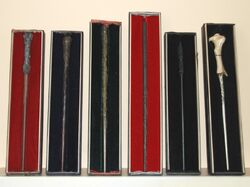
Various wands
Wand-wood
Bowtruckles, tree-guardians, opt to live in wand-trees whose wood is of wand quality - wand-wood. Therefore, it can be assumed that one can not simply walk into a forest, retrieve a twig, and create a wand. Wand-wood may already be magical or merely be the only type of wood strong enough to sustain the power of magic within.
Magical cores
Wands contain magical cores, possibly magically inserted once the wand has been carved. These magical cores enhance the wand magic or give the wand-wood magical abilities. The only cores able to produce magic are from magical species. Mr. Ollivander opts to only use phoenix feathers, unicorn hairs, and dragon heartstrings, which may be the most powerful and best of magical cores, as Ollivander's wands have been praised for being the best. Other materials, such as Veela hair, or even Thestral hair, have also been used by other wandmakers.
Wand length
All wands have their individual wand-lengths. The longest known wand once belonged to Rubeus Hagrid, made of oak with a length of sixteen inches. It was snapped in half after he was blamed for the opening of the Chamber of Secrets. The shortest known wand once belonged to Dolores Umbridge, who dropped it in the Forbidden Forest before it was snapped in half by a centaur's hoof. Her wand is described as being "unusually short".
There may also be some correlation between character's height and the lengths of their wands. Hagrid, who is a half-giant, has a very long wand, and Dolores Umbridge, who is described as being squat and toad-like, has a very short, stubby wand.
The creation of the Elder Wand
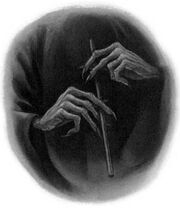
Lord Voldemort holding the Elder Wand.
The creation of the Deathly Hallow Elder Wand is highly unusual. In the book The Tales of Beedle the Bard, there is the legend of the Deathly Hallows called, The Tale of the Three Brothers. In the story, Death is asked by the oldest of the Peverell brothers to be given a wand that would win duels. Death approaches an Elder tree, retrieves a branch, and creates the Elder Wand.
It is not said if this tree bore wand-wood. Death did not even give the wand a magical core. This is possibly what also makes it unique. However, Albus Dumbledore and many others who chased after the Deathly Hallows believe that it was actually created by Antioch Peverell himself, instead of by Death. If this is the case, then it can be assumed that the wand indeed was made from a worthy Elder and has magical core of creatures who are involved with death, such as a Thestral hair.
The subtle laws of wands
- "The wand chooses the wizard. That much has always been clear to those of us who have studied wandlore...if you are any wizard at all you will be able to channel your magic through almost any instrument. The best results, however, must always come where there is the strongest affinity between wizard and wand. These connections are complex. An initial attraction, and then a mutual quest for experience, the wand learning from the wizard, the wizard from the wand."
- — Mr. Ollivander[src]
Wands possess a force of magic that itself has its own boundaries where none can go beyond. This is similar to Newton's Laws of Motion and other forces, and are known as The Subtle Laws of Wands[4].
The fundamental laws
Mr. Ollivander states that a wand chooses a wizard. It is not clear why, but certain wands seem to have a natural affinity for certain wizards or witches. This is the most fundamental law. The connections made between both wizard and wand are complex, and will grow with experience, the wand learning from the wizard, the wizard from the wand. This is the second law. Thirdly, a wizard may channel his energy with any wand, whether his or not. However, the best results come where there is a great likeness between a wizard and a wand.

Lastly, a wand may be won from its master, and only then will its allegiance bend towards the new master. This does not apply in situations such as practice duels, in which being disarmed or defeated will not affect a wand's loyalty. Wands develop an affinity to their owners that they will not give up easily; even when won, they will often retain some loyalty to the original owner. The only exception to this is the Elder Wand, which is "completely unsentimental" and will only be loyal to strength. In other words, when won, it switches its allegiance entirely.[5] When a wand has not been won, it will not work as well for its new owner, as when Harry Potter was forced to use a blackthorn wand and when Hermione Granger used Bellatrix Lestrange's wand, neither of which they had won.[2]
- Hermione: "I hate that thing. I really hate it. It feels all wrong, it doesn’t work properly for me… It’s like a bit of her."
- Ron: "It’ll probably help you get in character, though. Think what that wand’s done!"
- Hermione: "But that’s my point! This is the wand that tortured Neville’s mum and dad, and who knows how many other people? This is the wand that killed Sirius! I miss my wand."
- — Hermione on using Bellatrix Lestrange’s wand[src]
In some families, wands may be inherited, such as Neville Longbottom using his father's wand and Ron Weasley using his brother Charlie's old wand. However, each of these cases ended with the wands being snapped in half, and both Neville and Ron were more successful using other wands, therefore making it questionable that one can fully master a wand gained in this way.
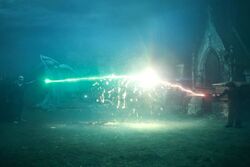
Priori Incantatem between Harry Potter and Voldemort in 1995.
Priori Incantatem
Two wands with the same magical cores coming from the same magical creature, referred to as "brothers", cannot be forced to duel against one another. Should two such wands ever come in the way of one another, a rare connection is formed called, Priori Incantatem. When the connection is formed, the wands battle to merge a golden orb into the other's shaft; the one that succeeds to force the orb in the other is the winning wand. Because of its rarity, most wizards never learn that such a connection is possible - this is the first law of Priori Incantatem.
After two brother wands connect through means of Priori Incantatem, both wands come to know one another and may react towards each other without the consent of their owners, or the winning wand only reacts towards the losing wand - this is the second law of Priori Incantatem[6]. Also, under special conditions it is possible for one wand to recognize its "brother's" master, even when a different wand is used. For example, during the Battle over Little Whinging, Harry's wand recognized Voldemort and spurted "golden flames" at him, even though Voldemort was using Lucius Malfoy's wand at the time.[2]
Damaged wands
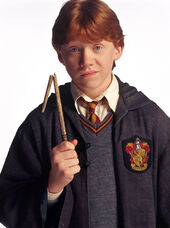
Ron Weasley with his broken wand.
Wands that have suffered an immense degree of damage can not be fixed by any means most wandmakers know, except with help from the Elder Wand, as seen when Harry Potter's wand was broken from a reflected Blasting Curse and Hermione Granger was unable to repair it. Harry later fixed it with the Elder Wand.[2]
Accomplished wandmakers
- Further information: Mr. Ollivander
Two of the most accomplished wandmakers were Ollivander and Gregorovitch. Ollivander was widely considered the best in Britain, while Gregorovitch was the best in his land which has remained unknown. Ollivander was kidnapped by Death Eaters for information on the connection between Harry Potter's wand and Voldemort's wand, but later escaped with the assistance of Dobby, while Gregorovitch was killed by Voldemort for not telling him who the thief of the Elder Wand was.[2] Ollivander also had an associate in Hogsmeade, who was learned in wandlore. It is unknown whether he also manufactured wands.
Apart from those, there were other lesser known wandmakers living and working in Britain, though not in the same vein as Ollivander, such as Jimmy Kiddell.
Behind the scenes
- Both the shortest wand (Dolores Umbridge's wand) and the longest wand (Rubeus Hagrid's wand) known in the series were snapped in half.
- In the Tales of Beedle the Bard commentary, Albus Dumbledore mentions that he is knoweleagable about wandlore.
See also
Notes and references
- ↑ 1.0 1.1 1.2 Harry Potter and the Philosopher's Stone
- ↑ 2.0 2.1 2.2 2.3 2.4 2.5 Harry Potter and the Deathly Hallows
- ↑ 3.0 3.1 3.2 The Celtic Tree Calendar
- ↑ Deathly Hallows, chapter 24
- ↑ [http://www.accio-quote.org/articles/2007/1224-pottercast-anelli.html PotterCast 131
- ↑ Harry Potter and the Goblet of Fire
